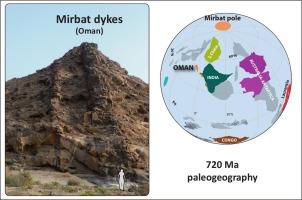East side story of Gondwana: the last frontier of the Arabian Nubian shield at 720 Ma based on new high-quality paleomagnetic pole
IF 7.2
1区 地球科学
Q1 GEOSCIENCES, MULTIDISCIPLINARY
引用次数: 0
Abstract
Unraveling the paleogeography is crucial to understand the changes in Earth Systems at the onset of the Cryogenian Period around ∼720 Ma. The Cryogenian Period is marked by widespread glaciations notably preserved in the Arabian Nubian Shield, and is a turning point in the supercontinent cycle between the dispersal of the Rodinia supercontinent and the assembly of Gondwana. Filling gaps from the paleomagnetic database remains an indispensable tool to solve the Proterozoic paleogeographic and paleogeodynamic puzzle, especially during challenging periods of continental dispersion. Through a detailed coupled paleomagnetic, structural and geochronologic study, the Shaat dyke swarm (∼720 Ma), intruding the Mirbat basement on the south-western coast of the Oman sultanate, has proven to be reliable witnesses of the evolution of the ancient Earth. A characteristic remanent magnetization (ChRM) was isolated in stable single to pseudo-single domain (SD/PSD) magnetite. Well constrained site mean directions obtained for 20 dykes lead to a mean direction for the Shaat dyke swarm of Dm = 249.9°, Im = −61.3° (N = 20, α95 = 5°, k = 43.1), yielding a paleomagnetic pole at 104.9°E, 25.9°N, (A95 = 7.2°, K = 21.3). The reliability of the paleomagnetic pole is assessed by 5 of the 7 Criteria of Meert et al. (2020). This new key paleomagnetic Mirbat pole represents the only reliable paleomagnetic pole for the Omani Neoproterozoic block/terrane at ∼720 Ma. It confirms the connection between the Omani terrane and the Indian Shield (already link to the Seychelles and Madagascar blocks) and defines a medium paleolatitude of ∼42.4° for the Omani block at ∼720 Ma. The confirmed connection also implies a moderate latitude (∼40°) for the Indian Shield at the beginning of the major Sturtian glaciation.

冈瓦纳东部的故事:基于新的高质量古磁极的720 Ma阿拉伯努比亚地盾的最后边界
解开古地理对于理解大约720 Ma左右的低温期开始时地球系统的变化至关重要。低温期以广泛的冰川作用为标志,特别是在阿拉伯努比亚盾中保存下来,是罗迪尼亚超大陆分散和冈瓦纳聚集之间的超大陆旋回的转折点。填补古地磁数据库的空白仍然是解决元古宙古地理和古地球动力学难题不可或缺的工具,特别是在大陆分散具有挑战性的时期。通过详细的古地磁、构造和地质年代学耦合研究,侵入阿曼苏丹国西南海岸Mirbat基底的Shaat堤群(~ 720 Ma)已被证明是古地球演化的可靠见证。在稳定的单畴和伪单畴(SD/PSD)磁铁矿中分离出特征残余磁化(ChRM)。得到的20条岩脉的限定位置平均方向为Dm = 249.9°,Im = - 61.3°(N = 20, α95 = 5°,k = 43.1),得到的古磁极位于104.9°E, 25.9°N, (A95 = 7.2°,k = 21.3)。根据Meert et al.(2020)的7个标准中的5个标准评估古磁极的可靠性。这个新的关键古地磁Mirbat极代表了阿曼新元古代地块/地体在~ 720 Ma的唯一可靠的古地磁极。它证实了阿曼地块与印度地盾之间的联系(已经与塞舌尔和马达加斯加地块相连),并确定阿曼地块在~ 720 Ma的古纬度为~ 42.4°。经证实的联系还表明,在斯图特大冰期开始时,印度地盾的纬度适中(~ 40°)。
本文章由计算机程序翻译,如有差异,请以英文原文为准。
求助全文
约1分钟内获得全文
求助全文
来源期刊

Gondwana Research
地学-地球科学综合
CiteScore
12.90
自引率
6.60%
发文量
298
审稿时长
65 days
期刊介绍:
Gondwana Research (GR) is an International Journal aimed to promote high quality research publications on all topics related to solid Earth, particularly with reference to the origin and evolution of continents, continental assemblies and their resources. GR is an "all earth science" journal with no restrictions on geological time, terrane or theme and covers a wide spectrum of topics in geosciences such as geology, geomorphology, palaeontology, structure, petrology, geochemistry, stable isotopes, geochronology, economic geology, exploration geology, engineering geology, geophysics, and environmental geology among other themes, and provides an appropriate forum to integrate studies from different disciplines and different terrains. In addition to regular articles and thematic issues, the journal invites high profile state-of-the-art reviews on thrust area topics for its column, ''GR FOCUS''. Focus articles include short biographies and photographs of the authors. Short articles (within ten printed pages) for rapid publication reporting important discoveries or innovative models of global interest will be considered under the category ''GR LETTERS''.
 求助内容:
求助内容: 应助结果提醒方式:
应助结果提醒方式:


